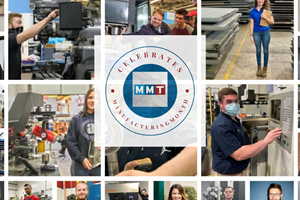ISO 9001 - Is the Payoff Worth The Effort?
Many companies that have implemented ISO 9001 report a variety of benefits, including improved quality performance, greater operating efficiency, cost reduction, improved employee awareness and enhanced public image, among others - making ISO 9001 a sound investment.
Every supplier in the plastics industry supply chain can benefit from some form of documented quality system (QS). The reason: solving similar problems over and over again is costly and counter-productive. Having a QS helps to systematically identify and eliminate problems and clarify procedures. It also is essential to improving product and customer service quality and to continually improving business operations. In addition, it helps set expectations and improves communication.
The system need not be very elaborate but should include at least written product specifications and/or process routings, work instructions, an equipment and gauge calibration system, a training program, controls in quoting and contracts and a system for handling customer complaints and rejected material. After all, problems can arise at any point from design to delivery of a product. Too often, the source of the problem is not where the pain is felt. Instead, those who suffer are the assemblers who deal with bad parts from a supplier or poor design considerations, the shipper who is missing paperwork or details from the sales office that gets the product out the door, or the customer who has to send a product back because of defects. Unsolved problems ultimately equal lost customers and unhappy employees.
That's where ISO 9001 - the international quality standard for quality management and quality assurance - comes into play. ISO 9001 provides a sound framework for achieving quality at every level in a company. It can be used for companies that want full ISO registration or as a roadmap to achieve higher product, process and customer service quality. It is important to understand that third-party registration is not required by the standard, although a company may be compelled by its business partners to obtain third-party registration.
A second-party, industry-specific ISO 9001 certificate of compliance for the plastics industry is the more business improvement approach. It is an independent watchdog that audits for conformance that has a number of added benefits:
- A distinction in the plastics marketplace from other companies.
- Continuing improvement through systematic review of processes by internal audits.
- Improved methods of identifying customer requirements and any changes needed.
- Greater employee involvement, understanding and commitment to achieving quality.
- Fewer audits by customers seeking assurance of quality.
The latest revision, ISO 9001:2000 - which has just been published - has a greater focus on how companies meet customer needs, integrate those needs into the operation and evaluate customer feedback (see table after article). It is the most extensive overhaul of the standard yet and requires top-level management leadership. The new updated standard is based on eight fundamental "best practices" that all organizations should have integrated into their business if they intend to keep up with their competition.
Improved customer relations are only one of a number of benefits of adopting such a company-wide quality system. Following ISO 9001 improves communications both inside and outside the firm. It reduces rework, scrap and product returns. It builds better supplier relationships through improved communications and feedback. An ISO 9001 system helps to create a reliable system for documenting procedures, which helps set performance expectations, promote consistency and can reduce new employee training time.
The greatest obstacle to adopting an ISO 9001 quality system is understanding what compliance to the standard really means, and then implementing the requirements in a simple and easy-to-use system. Because the standard can be applied across all industries, a first step for most companies is deciding what parts of the standard apply and identifying where any system already in place needs to be improved or modified. Many companies get stuck trying to fit the standard to their situation rather than implementing the basic controls and checks/balances that ISO looks for. Here the experience of plastics professionals can help a moldmaker/molder by clarifying which requirements are needed, what areas are to be placed under document control, and the easiest methods to show evidence of quality related activities.
How can moldmakers/molders meet the challenge?
If your shop is considering ISO 9001, there are a number of things you can do to simplify the effort:
Quality does not just happen. It requires an intentional effort on the part of top management and employees within the quality system. Obtaining certification to the ISO 9001 standard clearly shows customers and shareholders that consistent quality in products and customer service is important as well as vital for continued success.
|
Related Content
How to Improve Your Current Efficiency Rate
An alternative approach to taking on more EDM-intensive work when technology and personnel investment is not an option.
Read More2021 30 Under 30 Honors Program: Mentoring in the Next-Generation of Moldmaking Professionals
Young professionals are vital to the moldmaking industry, and it is important to acknowledge those making strides in shaping the industry's future. MoldMaking Technology recognizes the industry's young talent through its 30 Under 30 Honors Program.
Read MoreTackling a Mold Designer Shortage
Survey findings reveal a shortage of skilled mold designers and engineers in the moldmaking community, calling for intervention through educational programs and exploration of training alternatives while seeking input from those who have addressed the issue successfully.
Read MoreLeading Mold Manufacturers Share Best Practices for Improving Efficiency
Precise Tooling Solutions, X-Cell Tool and Mold, M&M Tool and Mold, Ameritech Die & Mold, and Cavalier Tool & Manufacturing, sit down for a fast-paced Q&A focused on strategies for improving efficiencies across their operations.
Read MoreRead Next
Reasons to Use Fiber Lasers for Mold Cleaning
Fiber lasers offer a simplicity, speed, control and portability, minimizing mold cleaning risks.
Read MoreAre You a Moldmaker Considering 3D Printing? Consider the 3D Printing Workshop at NPE2024
Presentations will cover 3D printing for mold tooling, material innovation, product development, bridge production and full-scale, high-volume additive manufacturing.
Read MoreHow to Use Strategic Planning Tools, Data to Manage the Human Side of Business
Q&A with Marion Wells, MMT EAB member and founder of Human Asset Management.
Read More













.jpg;maxWidth=300;quality=90)






_300x250 1.png;maxWidth=300;quality=90)







